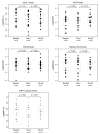A phase I trial of bortezomib with temozolomide in patients with advanced melanoma: toxicities, antitumor effects, and modulation of therapeutic targets
- PMID: 20028756
- PMCID: PMC3205975
- DOI: 10.1158/1078-0432.CCR-09-2087
A phase I trial of bortezomib with temozolomide in patients with advanced melanoma: toxicities, antitumor effects, and modulation of therapeutic targets
Abstract
Purpose: Preclinical studies show that bortezomib, a proteasome inhibitor, blocks NF-kappaB activation and, combined with temozolomide, enhances activity against human melanoma xenografts and modulates other critical tumor targets. We initiated a phase I trial of temozolomide plus bortezomib in advanced melanoma. Objectives included defining a maximum tolerated dose for the combination, characterizing biomarker changes reflecting inhibition of both proteasome and NF-kappaB activity in blood (if possible tumor), and characterizing antitumor activity.
Experimental design: Cohorts were enrolled onto escalating dose levels of temozolomide (50-75 mg/m(2)) daily, orally, for 6 of 9 weeks and bortezomib (0.75-1.5 mg/m(2)) by i.v. push on days 1, 4, 8, and 11 every 21 days. Peripheral blood mononuclear cells were assayed at specified time points for proteasome inhibition and NF-kappaB biomarker activity.
Results: Bortezomib (1.3 mg/m(2)) and temozolomide (75 mg/m(2)) proved to be the maximum tolerated dose. Dose-limiting toxicities included neurotoxicity, fatigue, diarrhea, and rash. Nineteen melanoma patients were enrolled onto four dose levels. This melanoma population (17 M1c, 10 elevated lactate dehydrogenase, 12 performance status 1-2) showed only one partial response (8 months) and three with stable disease >or=4 months. A significant reduction in proteasome-specific activity was observed 1 hour after infusion at all bortezomib doses. Changes in NF-kappaB electrophoretic mobility shift assay and circulating chemokines in blood failed to correlate with the schedule/dose of bortezomib, inhibition of proteasome activity, or clinical outcome.
Conclusions: We have defined phase II doses for this schedule of temozolomide with bortezomib. Although proteasome activity was inhibited for a limited time in peripheral blood mononuclear cells, we were unable to show consistent effects on NF-kappaB activation.
Figures




Similar articles
-
A phase I study of bortezomib and temozolomide in patients with advanced solid tumors.Cancer Chemother Pharmacol. 2012 Feb;69(2):505-14. doi: 10.1007/s00280-011-1721-x. Epub 2011 Aug 18. Cancer Chemother Pharmacol. 2012. PMID: 21850464 Free PMC article. Clinical Trial.
-
Phase I trial using proteasome inhibitor bortezomib and concurrent temozolomide and radiotherapy for central nervous system malignancies.Int J Radiat Oncol Biol Phys. 2009 Jun 1;74(2):433-9. doi: 10.1016/j.ijrobp.2008.08.050. Epub 2008 Dec 10. Int J Radiat Oncol Biol Phys. 2009. PMID: 19084346 Free PMC article. Clinical Trial.
-
A phase I clinical-pharmacodynamic study of the farnesyltransferase inhibitor tipifarnib in combination with the proteasome inhibitor bortezomib in advanced acute leukemias.Clin Cancer Res. 2011 Mar 1;17(5):1140-6. doi: 10.1158/1078-0432.CCR-10-1878. Epub 2011 Jan 13. Clin Cancer Res. 2011. PMID: 21233404 Free PMC article. Clinical Trial.
-
Proteasome inhibition and combination therapy for non-Hodgkin's lymphoma: from bench to bedside.Oncologist. 2012;17(5):694-707. doi: 10.1634/theoncologist.2011-0341. Epub 2012 May 7. Oncologist. 2012. PMID: 22566373 Free PMC article. Review.
-
Neurological adverse effects caused by cytotoxic and targeted therapies.Nat Rev Clin Oncol. 2009 Oct;6(10):596-603. doi: 10.1038/nrclinonc.2009.128. Epub 2009 Aug 25. Nat Rev Clin Oncol. 2009. PMID: 19707193 Review.
Cited by
-
Myeloid IKKβ promotes antitumor immunity by modulating CCL11 and the innate immune response.Cancer Res. 2014 Dec 15;74(24):7274-84. doi: 10.1158/0008-5472.CAN-14-1091. Epub 2014 Oct 21. Cancer Res. 2014. PMID: 25336190 Free PMC article.
-
A phase I study of bortezomib and temozolomide in patients with advanced solid tumors.Cancer Chemother Pharmacol. 2012 Feb;69(2):505-14. doi: 10.1007/s00280-011-1721-x. Epub 2011 Aug 18. Cancer Chemother Pharmacol. 2012. PMID: 21850464 Free PMC article. Clinical Trial.
-
Exploring major signaling cascades in melanomagenesis: a rationale route for targetted skin cancer therapy.Biosci Rep. 2018 Oct 2;38(5):BSR20180511. doi: 10.1042/BSR20180511. Print 2018 Oct 31. Biosci Rep. 2018. PMID: 30166456 Free PMC article. Review.
-
In vitro and in vivo efficacy of the novel oral proteasome inhibitor NNU546 in multiple myeloma.Aging (Albany NY). 2020 Nov 16;12(22):22949-22974. doi: 10.18632/aging.104023. Epub 2020 Nov 16. Aging (Albany NY). 2020. PMID: 33203800 Free PMC article.
-
HDAC inhibitor L-carnitine and proteasome inhibitor bortezomib synergistically exert anti-tumor activity in vitro and in vivo.PLoS One. 2012;7(12):e52576. doi: 10.1371/journal.pone.0052576. Epub 2012 Dec 20. PLoS One. 2012. PMID: 23285100 Free PMC article.
References
Publication types
MeSH terms
Substances
Grants and funding
LinkOut - more resources
Full Text Sources
Other Literature Sources
Medical

